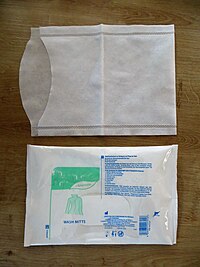Wet wipe
Wet wipes are single-use nonwoven cloths that are soaked in liquid and packaged in foil or dispenser cans. This includes products for skin cleaning, cleaning cloths (e.g. for furniture care, glass and glasses cleaning), disinfectant wipes and refreshing wipes .
The first wet wipe, "the Wet Nap", was invented in 1958. It was intended to be an easy-to-use item for on the go.
Wet wipes are problematic in wastewater because they do not disintegrate like toilet paper. Together with other components, they can form so-called mountains of fat or tear-resistant braids that clog sewers and sewage treatment plants . Therefore, the cloths should only be disposed of with household waste.
personal hygiene
Skin cleansing, hygiene or baby care wipes or moist toilet paper towels are soaked in cleaning lotion, which mostly consists of water and surfactants, but in addition to oils, emulsifiers and herbal ingredients also contain preservatives that protect the product from mold. These wet wipes are used for personal hygiene, especially on the go (e.g. when traveling). They are usually packaged in resealable bulk packs or individually packaged in a liquid-tight manner and can be disposed of with household waste after use. The advantage of damp toilet paper or baby wipes is that it is easier and gentler to clean the skin ; In contrast to the rougher dry toilet paper , this can prevent skin irritation in the sensitive anal area. However, these wipes themselves must not contain any skin-irritating or allergenic additives.
In some clinics, patients in need of care are washed with wet wipes instead of water and washcloths: one pack contains the number of wipes required for a full body wash, which are heated in the microwave before use. This type of skin cleansing is only suitable for a limited period of time.
Specially prepared wipes are used for MRSA remediation.
Disinfectant wipes
Disinfectant wipes impregnated with alcoholic solution for skin or surface disinfection are commercially available; some in dispenser cans that can be refilled with refills. Small, individually wrapped alcohol swabs are used to disinfect the skin, for example before an injection . There are also rolls of non-woven cloth that are placed in buckets with a surface disinfectant solution that you have made yourself or that has been taken from a dispenser; The soaked towels can be removed individually via a special opening in the lid.
See also
Web links
Individual evidence
- ↑ ikw.org ( Memento from April 17, 2016 in the Internet Archive ); accessed on December 10, 2019
- ↑ Dietmar Seher: Baby wipes paralyze pumping stations on the Ruhr . In: WAZ.de . 17th December 2016.
- ↑ 41 baby wipes in the test. Öko-Test Jahrbuch Kleinkinder 2018 from January 18, 2018, on oekotest.de (excerpt) ; accessed on December 21, 2018
- ↑ Dita Schmidt: What to watch out for in basic care. bibliomed-pflege.de , accessed on December 10, 2019.

